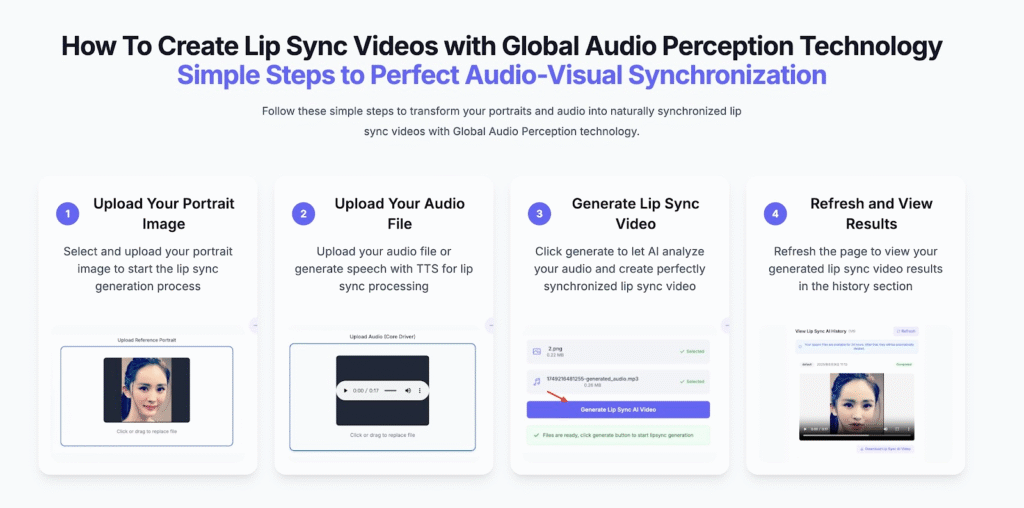The education sector stands at the forefront of a technological revolution that promises to transform how knowledge is delivered and absorbed. As educators and trainers grapple with evolving student expectations and the need for engaging, accessible content, AI lip sync technology emerges as a game-changing solution that addresses long-standing challenges in educational content creation.
Dive deeper into this topic with a related post you won’t want to miss!
Breaking Down Educational Barriers
Traditional educational video production has been a significant bottleneck for educators worldwide. Creating professional-quality instructional videos requires substantial time investment, technical expertise, and often expensive equipment that many educational institutions simply cannot afford.
Consider the multilingual education challenge. Universities with international student populations struggle to provide consistent, high-quality content across different languages. Traditional approaches require hiring native speakers, managing complex scheduling, and maintaining quality standards across multiple productions—a logistical nightmare that often results in inconsistent educational experiences.
Distance learning and online education platforms face similar challenges. Engaging students through screens requires production values that compete with entertainment media, yet educational budgets rarely accommodate professional video production costs.
Global Audio Perception: The Educational Game-Changer
Revolutionary Global Audio Perception technology addresses these challenges by treating audio as the primary driver of natural, expressive video content. For educators, this means transforming any lecture, explanation, or instructional audio into professional-quality video content with lifelike facial expressions and natural lip synchronization.
This technology goes beyond simple lip movement matching. It analyzes the emotional and tonal qualities of educational content, generating appropriate facial expressions that enhance learning engagement. When explaining complex concepts, the technology captures the instructor’s enthusiasm or concern, translating these nuances into visual cues that help students better understand and retain information.
The system’s ability to maintain temporal consistency across longer content pieces is particularly valuable for educational applications. Extended lectures or training sessions maintain natural flow without the jarring animation inconsistencies that can distract from learning objectives.

AudioX: Professional Audio for Education
Educational content creation reaches new heights when combined with AudioX‘s professional audio generation capabilities. This powerful platform provides educators with tools that were previously available only to major educational publishers.
AudioX’s comprehensive audio generation features transform educational content creation:
- Text to Audio: Convert lesson plans and educational scripts into professional narration across multiple languages and voices
- Text to Music: Generate appropriate background music for different types of educational content, from energetic introduction music to calming background audio for meditation or relaxation training
- Image to Audio: Create immersive soundscapes for history lessons, science demonstrations, or cultural studies by generating audio that matches historical images or scientific diagrams
- Video to Audio: Generate synchronized sound effects for educational videos, making science experiments, historical reenactments, or technical demonstrations more engaging
- Video to Music: Create background music that perfectly matches the pace and mood of educational video content
Transforming Educational Delivery Models
The combination of AI lip sync technology and professional audio generation is revolutionizing how educational institutions deliver content. Language schools are creating immersive learning experiences by generating native speaker audio through AudioX, then using AI lip sync to create authentic-looking conversation partners for students.
Corporate training departments are developing consistent, multilingual training modules that maintain the same quality and engagement levels across different languages and cultural contexts. This consistency ensures that all employees, regardless of location or language preference, receive equivalent training experiences.
Medical and technical training programs are particularly benefiting from this technology combination. Complex procedures and explanations that require precise timing and clear communication can now be delivered with perfect synchronization and professional production values, regardless of the instructor’s on-camera presence or technical recording setup.
Universities are expanding their online course offerings by enabling professors to create engaging video content without requiring on-camera appearances. This flexibility is particularly valuable for educators who may be uncomfortable with traditional video recording or who want to maintain some level of anonymity while still providing engaging visual content.
Accessibility and Inclusion Revolution
Perhaps most importantly, this technology dramatically improves educational accessibility. Students with hearing impairments benefit from clear, natural lip reading opportunities that accurately reflect spoken content. The visual consistency and natural expressions generated by Global Audio Perception technology provide reliable visual cues that support comprehension.
Multilingual learners gain access to content that maintains the same visual quality and engagement across different languages. This consistency helps create inclusive learning environments where language barriers don’t translate into quality differences in educational delivery.
Cultural sensitivity in educational content is enhanced through the ability to generate appropriate visual representations that match diverse student populations while maintaining consistent educational quality.
Cost-Effective Scalability
Educational institutions face constant pressure to do more with limited budgets. The combination of AI lip sync and professional audio generation technology provides unprecedented scalability without proportional cost increases.
A single educator can now create multilingual course content that previously would have required hiring multiple instructors, translators, and production teams. This efficiency allows institutions to expand their educational offerings, reach broader student populations, and maintain high production standards without overwhelming budget increases.
The technology also enables rapid content updates and revisions. When curriculum changes or new information becomes available, educators can quickly generate updated content without requiring complete re-production of video materials.
Future of Educational Content
The integration of AI lip sync and professional audio generation technology represents just the beginning of a broader transformation in educational content creation. As these tools become more sophisticated and accessible, we can expect to see entirely new forms of educational delivery that were previously impossible or cost-prohibitive.
Interactive educational experiences, personalized instruction at scale, and immersive learning environments are becoming achievable goals for educational institutions of all sizes. The democratization of professional-quality content creation means that innovative educational approaches are no longer limited to well-funded institutions.
Embrace the Educational Future
For educators ready to transform their teaching approach and institutional leaders looking to enhance their educational offerings, this technology combination provides immediate, measurable benefits. Professional-quality educational content creation is now accessible through LIP SYNC, offering advanced AI lip sync technology in an educator-friendly platform.
Combined with the comprehensive audio generation capabilities at AudioX, educators have access to a complete solution for creating engaging, accessible, and professional educational content that rivals any major educational publisher.
The future of education is being written today, and it’s more inclusive, accessible, and engaging than ever before. The question isn’t whether this technology will transform educational content creation—it’s how quickly educational institutions will embrace these tools to provide better learning experiences for students worldwide.
Spotlight on this featured post—our top pick you shouldn’t skip.






